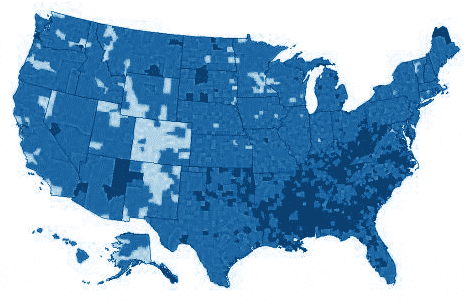The Centers for Disease Control and Prevention (CDC) found a certain area of the United States has the highest rates of type 2 diabetes. These 15 states are referred to as the “diabetes belt.” Discover where the diabetes belt is and why.
-
- The CDC determined the highest rates of diabetes in the United States are in a diabetes belt. The diabetes belt is similar to the “stroke belt” found in earlier studies. The diabetes belt is in 15 mostly Southern states. The diabetes belt includes 644 counties in parts of Alabama, Arkansas, Florida, Georgia, Kentucky, Louisiana, Mississippi, North Carolina, South Carolina, Ohio, Pennsylvania, Tennessee, Texas, Virginia and West Virginia. About 12 percent of the people in these areas have type 2 diabetes compared with 8.5 percent in the rest of the nation.
- About a third of the difference in diabetes prevalence between these areas and the rest of the United States is associated with obesity and sedentary lifestyles. The CDC identified regions that most need efforts to prevent diabetes type 2 and help people who have it manage the disease. Communities are encouraged to promote physical activity and access to healthy food to help people initiate positive lifestyle changes to reduce the risk of type 2 diabetes.
- Four factors distinguish the diabetes belt from the rest of the country. Over 32 percent of the people in the diabetes belt were obese, compared to about 26 percent in the rest of the U.S. The diabetes belt counties have more African-Americans than the rest of the nation. Just less than 25 percent of the people in the diabetes belt have a college degree while about 34 percent have a college degree in the rest of the country. Plus around 30 percent of the people in the diabetes belt have sedentary lifestyles versus about 25 percent in the rest of the country.
- About 37 percent of excess risk in the diabetes belt comes from factors that cannot be modified such as gender, race, education and age. Around 30 percent of the increased risk of developing diabetes is due to risk factors that can be modified such as obesity and lack of physical activity. Eat a diet that includes low-fat dairy, whole grains, lean meat and fish and vegetables and fruit. Exercise for at least 30 minutes, 5 days a week.
- Additional factors that seem to contribute to the higher rate of diabetes in the Southern states include cultural and social traditions. Public health officials are urged to think about culturally appropriate interventions to minimize obesity and sedentary lifestyle. Individuals can make positive changes such as eating grilled chicken over fried chicken and swapping out fattening treats for sugar-free desserts.
Income is another factor that could lead to poor dietary habits. People who are struggling to pay bills might be more worried about putting food on the table than choosing healthy foods. Additionally, cheaper foods tend to be denser. Some low income people live in areas where it is harder to find healthy foods or places to be physically active. Local farms can provide affordable produce options and some people grown their own at home in the yard or in container gardens. Most areas in the Diabetes Belt have access to YMCA memberships which offer educational classes on diabetes, support groups as well as weight machines and aerobic equipment.
- Many people in the diabetes belt have limited or no insurance coverage and may not have access to health care. States with the highest percentages of people living below the poverty line also have the lowest percentages of residents with health insurance and the fewest health care providers. Reach out to learn more about free or low-cost community health care centers and government health care assistance to get the care you need.
- The diabetes belt and stroke belt share many of the same risk factors such as sedentary behavior, obesity, high blood pressure and high cholesterol. Diabetes can increase the risk of blood vessel damage which can lead to a stroke. Being active and choosing the right foods can help ward off serious health condition.
Defining the diabetes belt is the first step toward raising awareness in our country. Federal and regional government officials are encouraged to help people through the initiation of diabetes awareness programs. Individuals can take steps to eat better, exercise more and learn about how to maintain a healthy lifestyle.







Leave A Comment